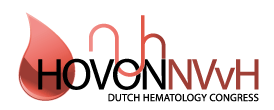Results of the Phase II Randomized Trial EMN15/HOVON147: Carfilzomib-Lenalidomide-Dexamethasone Vs Lenalidomide-Dexamethasone in Patients with High-Risk Smoldering Multiple Myeloma
- Receipt of honoraria or consultation fees J & J, Sanofi, BMS
- Participation in a company sponsored speaker's bureau J & J
- Scientific advisory board Sanofi, BMS
Standard treatment for smoldering multiple myeloma (SMM) consists of active surveillance according to international guidelines, yet some current guidelines advise lenalidomide with or without dexamethasone(R(d)) for high-risk SMM(HR-SMM) based on two randomized phase 2 trials comparing lenalidomide with/without dexamethasone in comparison to active surveillance. Adding a third agent, carfilzomib, to Rd (KRd), showed even more efficacy in a single arm phase 2 trial.
This phase 2, international, multi-center, randomized, open label, superiority EMN15/HOVON147 study assessed efficacy and safety of KRd versus Rd in patients with HR-SMM. HR-SMM patients were identified based on MAYO and/or PETHEMA criteria and randomized 2:1 to KRd (Cycles1-9 carfilzomib 20/56 mg/m2,lenalidomide 25mg,dexamethasone 20mg cycles1-4 and 10mg cycles5-9) or Rd as described; followed by lenalidomide dosing (10 mg days1-21 of a 28-day cycle for 24 cycles).
The primary endpoint was the rate of MRD negativity by next generation flowcytometry (NGF)(10-5) after induction treatment. Secondary endpoints included rate of NGF MRD negativity(10-5) after 4 induction cycles and PFS, using the IMWG criteria for biochemical progression and/or development of CRAB. MRD rates were evaluated based on modified intention-to-treat (m-ITT) analysis, patients with missing MRD data were considered as positive. Data cut-off for the analysis was July11,2024.
58 patients were included in the trial, 23 in arm A(Rd) and 35 in arm B(KRd). Patient characteristics in the Rd and KRd arms were well balanced: median age was 63 and 61 years, respectively. Median follow-up in the trial was 34 months, inter-quartile range (IQR)21-48. Median number of cycles of total treatment was 16 in arm A, and 27 in arm B.
Rates of m-ITT MRD negativity at 10-5 cut-off after 9 induction cycles were 57% versus 5% in the KRd versus Rd arm (odds ratio(OR)=0.04, 95%confidence interval(CI)=0.00-0.28; P<0.001). This translated into a significantly higher 3-years PFS benefit with KRd versus Rd, 94% versus 40%, (hazard ratio(HR)=0.08 (95% CI=0.02-0.35; P< 0.001). MRD negativity after 4 induction cycles was not significantly better in the KRd arm, 37% versus 14% (OR=0.27, 95%CI 0.06-1.12; P=0.07).
At least one grade 3-4 (non)-hematologic AE occurred in 74% versus 53% of KRD versus Rd treated patients. Less patients went off protocol due to progression in the KRd arm, 6% versus 36% in the Rd arm. Rate of discontinuation for toxicity was higher in the KRd arm, 26% versus 9%, respectively. No treatment-related deaths occurred, two deaths occurred in the Rd arm, after disease progression.
Treatment with KRd was observed to be feasible and safe in patient with HR-SMM. Nine cycles of KRd treatment significantly increased flow MRD negativity rates (10-5) as compared to Rd, which translated into a superior PFS.

